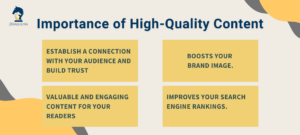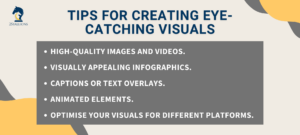SHARE

Creating high-quality content is essential for any business or individual looking to engage their audience and build their brand image. In today’s competitive digital landscape, where attention spans are short and competition is fierce, producing content that stands out and resonates with your target audience is crucial.

Understanding the Importance of High-Quality Content
High-quality content plays a vital role in audience engagement. It is the backbone of any successful marketing strategy, as it helps you establish a connection with your audience and build trust. When you consistently provide valuable and relevant content, your audience tends to engage with your brand and share your content with others.
Moreover, high-quality content also boosts your brand image. You position yourself as an authority in your field by delivering well-crafted and informative content. This helps you attract more followers and encourages others to view your brand as credible and trustworthy.
Creating high-quality content involves understanding your target audience’s needs and preferences. By conducting thorough research and analysis, you can tailor your content to address specific pain points and interests, making it more valuable and engaging for your readers. This level of personalisation enhances the overall quality of your content and fosters a stronger connection with your audience.
Furthermore, high-quality content is essential for improving your search engine rankings. Search engines like Google prioritise relevant, informative, and well-structured content. By consistently producing high-quality content, you increase your chances of ranking higher in search results, driving more organic traffic to your website and expanding your online visibility.

Identifying your audience’s preferences
Knowing your audience is the key to creating content that resonates with them. Understanding their preferences, interests, and pain points allows you to tailor your content to their needs. When you address their specific concerns and interests, you significantly increase the chances of capturing their attention and keeping them engaged.
Conducting audience research is crucial for gaining insights into your target audience. Use analytical tools to understand their demographics, browsing habits, and social media engagement. Additionally, engage with your audience through surveys, interviews, and social media interactions to understand their preferences deeply.
Furthermore, it is essential to consider the cultural nuances and regional differences that may impact your audience’s preferences. Different regions have varying customs, traditions, and societal norms that can influence how your content is perceived. Acknowledging and adapting to these cultural factors can ensure your message resonates with a diverse audience.
Moreover, paying attention to emerging trends and technological advancements can provide valuable insights into what captures your audience’s interest. Staying informed about the latest innovations in your industry and incorporating them into your content strategy can help you stay ahead of the curve and maintain relevance with your audience.

Crafting content that resonates with your audience
One effective way of creating content that resonates with your audience is through storytelling. Stories have a powerful impact on people, evoking emotions and connecting personally. Incorporate stories into your content to make it relatable and engaging.
Another effective technique is using emotion to connect with your audience. Evoking emotions, such as happiness, inspiration, or even sadness, can lead to increased engagement. Craft your content in a way that stirs emotions, whether through personal anecdotes, inspiring messages, or thought-provoking questions.
When crafting content, it’s essential to understand your audience’s preferences and interests. Conducting thorough research on your target demographic can provide valuable insights into what resonates with them. By tailoring your content to match their preferences, you can increase the likelihood of capturing their attention and fostering a deeper connection.
In addition to storytelling and emotional appeal, incorporating visual elements can significantly enhance the impact of your content. You can utilise images, videos, infographics, and other visual aids which help break up text-heavy content and make it more visually appealing. Visual content can attract and retain audience attention more effectively than text alone, making it valuable in creating engaging and resonant content.
Ensuring your content is informative and valuable
A good balance between entertaining and informative content is crucial for keeping your audience engaged. While entertaining content catches attention, the informative aspect keeps them returning for more. Provide valuable information, actionable tips, and insightful perspectives your audience can apply to their lives or businesses.
Additionally, thorough research is key to creating informative content. Take the time to gather accurate and up-to-date information from credible sources. Back up your claims with evidence and statistics, making your content credible and trustworthy.
Moreover, when crafting informative content, it is essential to consider the readability and accessibility of the information. Utilising clear headings, bullet points, and concise paragraphs can enhance the overall readability of your content, ensuring that your audience can easily grasp the key points being presented.
Apart from adding headings and bullet points, it is also crucial to use simple wording and straightforward sentence structures to enhance clarity. If achieving this manually seems challenging, go for a rephrasing tool like Paraphrase Online that will automatically simplify your text while keeping its meaning intact.
Furthermore, incorporating real-life examples and case studies can help illustrate complex concepts and make the information more relatable to your audience. By providing practical applications of the information you share, you can enhance the value of your content and increase its impact on your readers.

Making your content visually appealing
Visuals play a crucial role in capturing and retaining your audience’s attention. You can incorporate eye-catching visuals such as images, videos, infographics, and charts to make your content more visually appealing.
When choosing visuals, consider their relevance to the topic and how they can enhance the overall message. Use high-quality images and videos that are clear and visually appealing. Additionally, break up your content with subheadings, bullet points, and numbered lists to make it easier to read and digest.
Enhancing your content with visually stimulating elements makes it more attractive and aids in conveying complex information more understandably. The strategic use of colours, fonts, and layout can significantly impact how your audience engages with your content. Remember, a well-crafted visual can speak volumes and leave a lasting impression.
Tips for Creating Eye-catching Visuals
- Use high-quality images and videos that are relevant to your content.
- Create visually appealing infographics to present data engagingly.
- Add captions or text overlays to your visuals to provide context and reinforce your message.
- Consider using animated elements to add interest and make your visuals more dynamic.
- Optimise your visuals for different platforms to ensure they display correctly and load quickly.
Creating high-quality content requires dedication and attention to detail. By understanding the importance of valuable content, knowing your audience, crafting engaging narratives, delivering informative material, and incorporating eye-catching visuals, you can create content that the audience will love and help elevate your brand to new heights.
What are the key elements of high-quality content?
How can I make my content more engaging for my audience?
To make content more engaging, use a compelling narrative, incorporate interactive elements like quizzes and videos, use conversational language, and include calls-to-action that encourage reader participation.
What strategies can be used to understand audience preferences?
How does SEO contribute to the quality of content?















